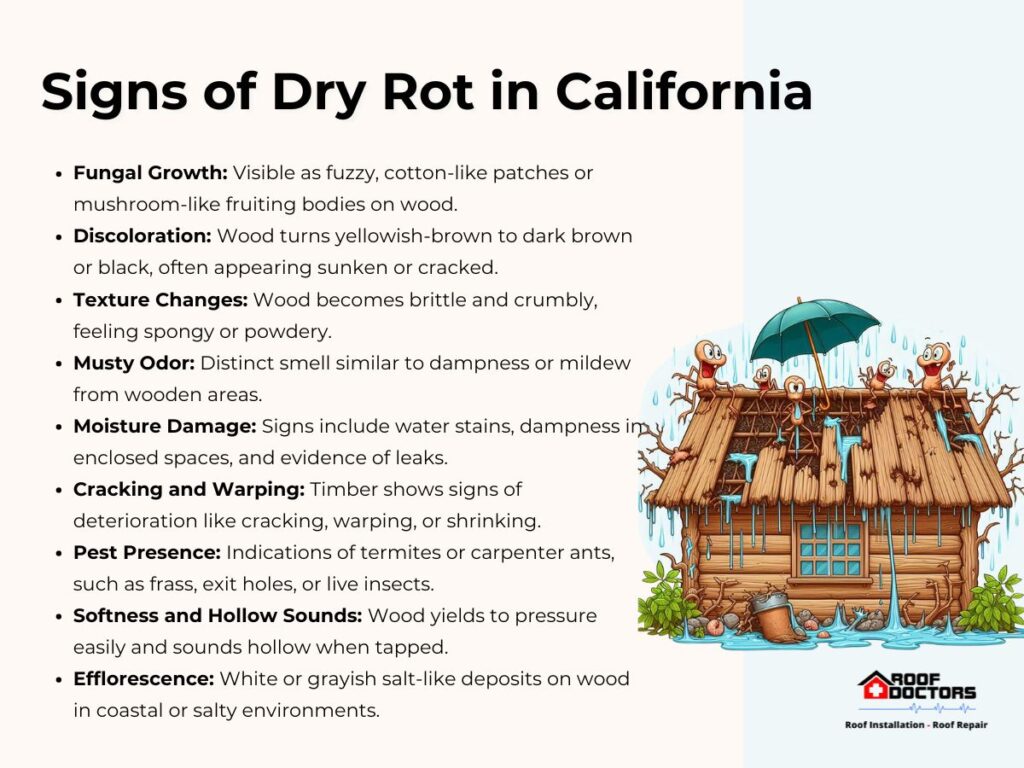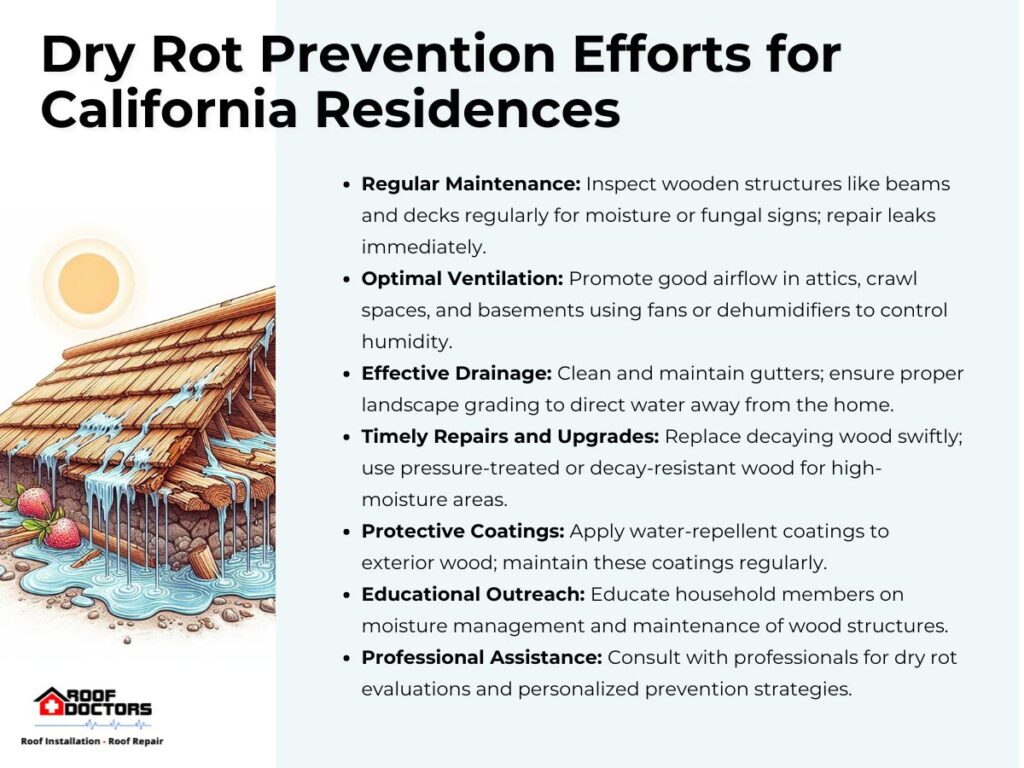Preventing Dry Rot in California: In California’s diverse landscapes, dry rot threatens wooden structures from arid deserts in the south to misty coastlines in the north. Homeowners and property managers seek comprehensive strategies to combat this issue.
This article explores climate-specific maintenance practices tailored to California’s varied environments, focusing on coastal, desert, mountainous, and urban landscapes. By emphasizing meticulous moisture management, resilient materials, and proactive maintenance, readers are empowered to safeguard their structures against fungal decay.
Through these strategies, residents can fortify their homes against dry rot, ensuring resilience in the face of environmental challenges. Through education and collaboration, we aim to create a lasting built
Environment.
Understanding Dry Rot: A California Twist
Dry rot is a form of wood decay caused by certain species of fungi, typically of the genus Serpula, Coniophora, or Meruliporia. These fungi thrive in environments with high moisture levels and poor ventilation. When wood becomes damp or wet for an extended period, it provides an ideal habitat for the fungi to grow and feed on the cellulose and lignin, which are the main components of wood. As the fungi consume these materials, they gradually weaken the wood’s structure, causing it to become brittle, crumbly, and prone to crumbling away.
Dry rot can spread rapidly throughout wooden structures, compromising their integrity and posing a safety hazard. It is characterized by distinctive signs such as fungal growth (often with a cottony or mushroom-like appearance), discoloration, cracking, and a musty odor. Preventing dry rot involves controlling moisture levels, improving ventilation, and promptly addressing any signs of fungal infestation to preserve the structural integrity of wooden buildings and objects.
California’s Mediterranean climate, with warm, dry summers and mild, wet winters, provides these fungi with the perfect balance. Fungal spores can easily enter through cracks, faulty building materials, or constant contact with damp soil. Once established, dry rot silently consumes wood, weakening its structure and causing significant damage.
Identifying the Enemy: Signs of Dry Rot in California
Dry rot, also known as wood decay, is a common and destructive issue faced by property owners across California. This fungal infestation thrives in environments with high moisture content and poor ventilation, making the diverse climate of California particularly conducive to its growth.
Recognizing the signs of dry rot early on is crucial for preventing extensive damage to timber structures. In this article, we outline key indicators of dry rot in California, empowering property owners to take proactive measures to combat this formidable foe.

Visual Indications
- Fungal Manifestation: Among the most conspicuous signs of dry rot is the presence of fungal growth on timber surfaces. This may manifest as fuzzy, cotton-like growth or mushroom-like structures known as fruiting bodies.
- Discoloration: Infected wood often displays discoloration, ranging from yellowish-brown to dark brown or black. Affected areas may exhibit sunken or cracked appearances, indicating advanced decay.
- Texture Alterations: Dry rot causes wood to become brittle and crumbly. Affected timber may lose its structural integrity, presenting surfaces with a spongy or powdery texture upon manipulation.
Musty Odor
Dry rot fungi emit a distinctive musty odor, akin to dampness or mildew. Property owners should remain vigilant for any unusual odors emanating from wooden structures, as they may signify underlying fungal infestations.
Moisture-Related Damage
Dry rot thrives in moist settings, hence signs of water damage often accompany its presence. These may include water stains on walls or ceilings, dampness in crawl spaces or basements, or visible indications of plumbing or roofing leaks.
Cracking and Distortion
As dry rot advances, affected timber may demonstrate visible signs of deterioration such as cracking, warping, or shrinking. This can manifest as distorted or misshapen wooden elements, including floorboards, beams, or window frames.
Presence of Pests
While dry rot is primarily caused by fungi, it can attract wood-boring insects like termites and carpenter ants, exacerbating structural damage. Vigilance for signs of insect activity, such as sawdust-like frass, exit holes in wood, or the presence of live insects, is imperative.
Softness and Hollow Sounds
Upon examination, wood suspected of dry rot may reveal soft spots or areas that yield easily to pressure. Furthermore, tapping on timber surfaces may produce hollow sounds, indicating substantial internal decay.
Efflorescence
In coastal regions or areas with high salt content in the air, efflorescence may materialize on the surface of affected wood. This presents as white or grayish crystalline deposits and can signify decay linked to moisture.
Recognizing the signs of dry rot is essential for preserving the structural integrity of timber structures in California. By remaining vigilant for visual cues, musty odors, moisture damage, and other indicators, property owners can identify and address dry rot infestations in their early stages.
Prompt action, including moisture control measures, fungal treatment, and timber repairs, can help mitigate the spread of dry rot and safeguard against extensive damage. With proactive maintenance and timely interventions, property owners can protect their investments and ensure the longevity of wooden structures in the diverse climate of California.
Climate-Specific Maintenance Practices
From the arid deserts of the south to the temperate coastlines and alpine regions of the north, each area presents unique challenges for preventing and combating dry rot. Implementing California-specific prevention strategies is crucial to mitigate the risk of fungal decay and preserve the integrity of wooden structures.
Given California’s unique climate, here are some essential maintenance practices to prevent dry rot:
Coastal Areas
- Moisture Control: Given the high coastal humidity, managing moisture levels is crucial. Install adequate ventilation systems in crawl spaces, basements, and attics to reduce humidity and deter fungal growth.
- Regular Inspections: Conduct frequent checks on decks, patios, and exterior surfaces to promptly detect and address any signs of moisture intrusion or fungal activity.
- Material Choices: Opt for moisture-resistant building materials and coatings to fortify structures against fungal decay common in coastal environments.
Desert Regions
- Water Management: Despite low humidity, sporadic rainfall and flash floods can foster pockets of moisture conducive to dry rot. Implement water management tactics like grading, drainage systems, and rainwater harvesting to prevent water accumulation near buildings.
- Sealing and Protection: Seal cracks and gaps in building exteriors to prevent water infiltration during infrequent rain events. Additionally, apply protective coatings and finishes to exposed wood surfaces for enhanced moisture resistance.
Mountainous Areas
- Drainage Solutions: Higher precipitation levels in mountainous regions necessitate robust drainage systems to divert surface water away from structures. Install gutters and downspouts to safely channel rainwater from building foundations.
- Insulation and Ventilation: Properly insulate exterior walls and attics to thwart condensation buildup and moisture penetration during colder weather. Ensure sufficient ventilation in enclosed spaces to promote airflow and diminish moisture retention.
Urban Environments
- Infrastructure Enhancements: Urban locales face unique challenges such as extensive impervious surfaces and dense development. Invest in green infrastructure initiatives like green roofs and permeable pavements to mitigate stormwater runoff and curb moisture levels.
- Plumbing Vigilance: Regularly inspect water supply lines and drainage systems to detect and rectify leaks promptly. Swiftly addressing plumbing issues prevents moisture infiltration into building structures.
- Community Education: Educate residents and property owners about proactive maintenance and moisture management practices crucial for dry rot prevention and the preservation of wooden structures in urban settings.
Effectively thwarting dry rot in California demands an understanding of its diverse climates and environmental nuances. By adopting region-specific tactics such as moisture control, routine maintenance, material selection, and infrastructure upgrades, property owners can combat dry rot and safeguard their investments.
Through proactive measures and community engagement, California can shield its built environment from the debilitating effects of dry rot, ensuring durable and sustainable structures for generations to come.
Enhancing Dry Rot Prevention Efforts for California Residences
In addition to tailored strategies based on California’s diverse climates, homeowners can implement further measures to fortify their homes against dry rot. These additional tips serve to bolster existing prevention efforts and minimize the risk of fungal decay in wooden structures. Here are some supplementary recommendations:

Regular Maintenance
- Conduct frequent inspections of all wooden elements such as beams, siding, and decks to detect early signs of moisture damage or fungal growth.
- Swiftly address any leaks in plumbing, roofs, or windows to thwart water intrusion into the home’s structure.
- Trim back vegetation surrounding the house to enhance airflow and reduce moisture buildup against wooden surfaces.
Optimal Ventilation
- Ensure sufficient airflow in areas like attics, crawl spaces, and basements to lower humidity levels and discourage fungal proliferation.
- Install ventilation systems, fans, or dehumidifiers where needed to maintain proper air circulation in enclosed spaces prone to dampness.
Effective Drainage
- Maintain gutters, downspouts, and drainage systems to ensure seamless water flow away from the foundation and exterior walls.
- Properly grade the landscape surrounding the house to facilitate surface runoff and prevent water pooling near wooden structures.
Timely Repairs and Upgrades
- Promptly fix or replace any deteriorating wooden components to prevent further moisture penetration and fungal infestation.
- Consider upgrading outdoor structures with pressure-treated or naturally decay-resistant wood, particularly in areas with high moisture levels.
Protective Coatings
- Apply water-repellent coatings, sealants, or paints to exterior wood surfaces as a barrier against moisture and fungal decay.
- Regularly inspect and maintain these protective layers to ensure ongoing effectiveness, especially in exposed areas subject to weathering and moisture.
Educational Outreach
- Educate household members about the importance of identifying and addressing moisture issues promptly to forestall dry rot and preserve the home’s structural integrity.
- Provide guidance on proper maintenance practices, including regular cleaning, sealing, and inspection of wooden surfaces.
Professional Assistance
Seek guidance from licensed contractors, inspectors, or pest control professionals for thorough evaluations of the home’s susceptibility to dry rot and personalized recommendations for prevention and treatment.
By incorporating these supplementary measures into their dry rot prevention plans, California homeowners can further shield their residences against the detrimental effects of fungal decay. A proactive stance toward maintenance, ventilation, drainage, and protective measures will help uphold the longevity and robustness of wooden structures in diverse environmental conditions.
Summary
In California’s varied climate, dry rot remains a persistent threat to wooden structures. Through tailored strategies and additional tips, homeowners can effectively combat this fungal decay. From managing coastal moisture to addressing desert drainage and enhancing urban infrastructure, each recommendation aims to fortify buildings against dry rot.
By implementing proactive measures like regular maintenance, optimal ventilation, and protective coatings, residents can safeguard their homes. Through education and collaboration with professionals, California communities can create resilient built environments capable of withstanding their ever-changing climate.
With a collective effort to prevent and address dry rot, homeowners can preserve the longevity and resilience of their structures, ensuring safe living spaces for generations to come.


